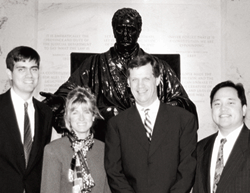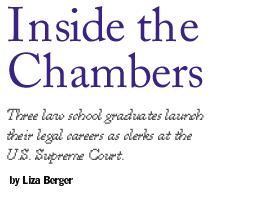

|
 |
 |
| At the Supreme Court are, from left, John Kelsh; Wendy Stone; Dave Van Zandt, dean of the School of Law; and Chris Yoo. |
From the earliest days of this country's history, the chambers of the
nine U.S. Supreme Court justices have been concealed from public
view, a virtual closed society to all but a privileged few. John Kelsh, Chris Yoo and Wendy Stone are among those fortunate exceptions. Recent graduates of the Northwestern University School of Law, they were granted firsthand knowledge of life behind the Supreme Court's doors as clerks during the High Court's 1997-98 judicial term. "It's probably the best job in the country," says Kelsh (L96), who clerked for Chief Justice William Rehnquist. "You get to deal with important issues at the highest levels. It was exciting to see how the court works." Kelsh took on 30 cases for the chief justice, frequently debating the merits of each side's arguments with him. "You had to be on your feet and well prepared," he notes with some understatement. For Yoo (L95), clerk to Associate Justice Anthony Kennedy, the experience marked the transition from student to lawyer. "He taught me about the importance of good judgment," the young man says. "He also taught me to appreciate complexity [in legal theory]." The stint also underscored one of the cruelest realities of life at the top - namely, a killing schedule. Most of the trio's time was spent recommending cases to be heard, writing briefs and drafting opinions. That sounds manageable, but typical days began at 7:30 a.m. and went on for 12 or 14 hours. A few all-nighters were thrown into the mix, too. On days when the court was sitting, the clerks attended oral arguments. "The one who wrote the bench memo led off the discussion and the justice challenged us with tough questions," says Stone (L95), one of Associate Justice Clarence Thomas' clerks. Kelsh adds, "It requires you on fairly short notice to master a subject and be able to discuss it. That was a little daunting. Occasionally, it was hard to work on such a deadline." Every day, the bulk of their time was spent writing suggestions to the justices about whether to hear a case. "Each term, the court receives 10,000 petitions for writs of certiorari, but it only grants 'cert' [agrees to hear the case] for about 100," says Stone. Yoo and Kelsh applied to clerk for all of the justices, but Stone only wanted Thomas, one of her heroes. "I never dreamed that I would have such an opportunity when I decided to apply to law school," she says. Stone inquired about the position while she was clerking for the U.S. Court of Appeals. She was invited to Washington, D.C., for an interview with Thomas and his four incumbent clerks. "The next week, he called me himself and offered me the job," Stone says. Northwestern-trained clerks are hardly foreign to the High Court. Newton Minow (S49, L50, H65), Walter H. Annenberg University Professor of Communications, Law and Policy and former chairman of the Federal Communications Commission, clerked for Chief Justice Fred M. Vinson for the 1951-52 term. Lawrence Marshall (L85), professor of law, clerked for Associate Justice John Paul Stevens (L47, H77) for the 1986-87 term, and this year one alumnus, Stephen Miller (L97), is clerking for Associate Justice Antonin Scalia. Next term, Michael Scudder (L98) will be clerking for Kennedy. "One of our strategic goals is to increase the percentage of our graduates who apply for judicial clerkships," says David E. Van Zandt, dean of the School of Law, who clerked for the late Associate Justice Harry Blackmun during the 1982-83 term. "As these graduates will attest, a judicial clerkship is a rewarding experience that provides an excellent foundation for any field the graduate wishes to pursue." So, what's a Supreme Court justice really like in his or her chambers? From the sound of it, most come across as "just folks," but decidedly smart ones. On some Saturday mornings, Thomas and his clerks talked about upcoming cases over bagels, cream cheese and coffee. "The discussions inevitably drifted into current events, history, literature or popular culture," Stone recalls. Yoo developed a deep admiration for Kennedy's openness to input. "He really cared about what we thought," Yoo says. "He used us as a sounding board to float different ideas. In doing so, he showed us the way he thought. ...It was a wonderful, cooperative process." Humor, too, occasionally crossed the chamber doors. Late one June night, Stone and her colleagues ran into Associate Justice David Souter and one of his clerks in the copy room. "We found a frustrated and bleary-eyed Justice Souter standing at the [photocopying] machine," she says. "'Do you know how this works?' he asked. We were stunned to find him making copies." After rescuing him from the paper jam, "we went off in search of another machine." Every weekend, Kelsh knocked a tennis ball around with Rehnquist and his other three clerks. They also played charades at his house. "Several [of the justices] can be quite humorous, including [the often dour-looking] Scalia," Kelsh says. Yoo and Kelsh, who won Northwestern's John Paul Stevens Prize for graduating first in their respective classes, have different plans for the future. Yoo wants to be a law professor and is currently working on appellate cases at the Washington, D.C., firm of Hogan & Hartson. Kelsh returned to Chicago and is a new associate with the law firm of Sidley & Austin. As a result of his experience at the Supreme Court, "I'm a little less nervous than I otherwise would have been," he says. Despite the hard work, long hours (and copier problems), all three emphatically state they would not have traded the experience for anything. "It's a tremendous opportunity to be an apprentice to some of the best lawyers in the country," says Steven Calabresi, Stone's law professor, who clerked for Scalia for the 1987-88 term. "If they want to be a judge, professor or work in a law firm, it will be regarded as a mark of distinction."
Liza Berger (WCAS97) is a graduate student in the Medill School of Journalism.
|

|
Supreme Courtship As if a clerkship in the highest court in the land isn't enough of an accomplishment, one clerk walked away with another ring of distinction - this one on her left hand. In November, Wendy Stone married Arthur Long, who also clerked for Associate Justice Clarence Thomas. Stone spoke with Long on the telephone before they started working in Thomas' chamber. "Justice Thomas played matchmaker," she says. While Stone says they tried to keep the friendship low-key, it did not elude her boss' watchful eye. At the exit interview, Thomas said, "On another matter, I know you and Arthur are dating, and I'm happy for you." Stone and Long, who reside in New York City, work for law firms and still keep in touch with Thomas. - L.B.
|